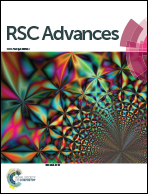Simulation of anodizing current–time curves and the morphology evolution of TiO2 nanotubes obtained in phosphoric electrolytes
Abstract
Although anodic TiO2 nanotubes (ATNTs) have been investigated for many years, the growth kinetics need to be further studied to work out a comprehensive fully theoretical model. Here, the simulation and separation of anodizing current–time curves are applied to investigate the morphology evolution in mixed NH4F/H3PO4 electrolytes for the first time. The total anodizing current was separated into ionic current and electronic current. The influence of NH4F concentration on the ionic current, electronic current and morphology evolution was systemically studied. The linear relationship between nanotube length and ionic current indicates that the ionic current contributes to oxide growth. It is the first time the special surface layer of nanotubes and two-hole nanotubes in mixed electrolytes have been observed. Furthermore, a formation mechanism for the two-hole nanotubes is proposed based on the plastic flow model and oxygen bubble mould.


 Please wait while we load your content...
Please wait while we load your content...